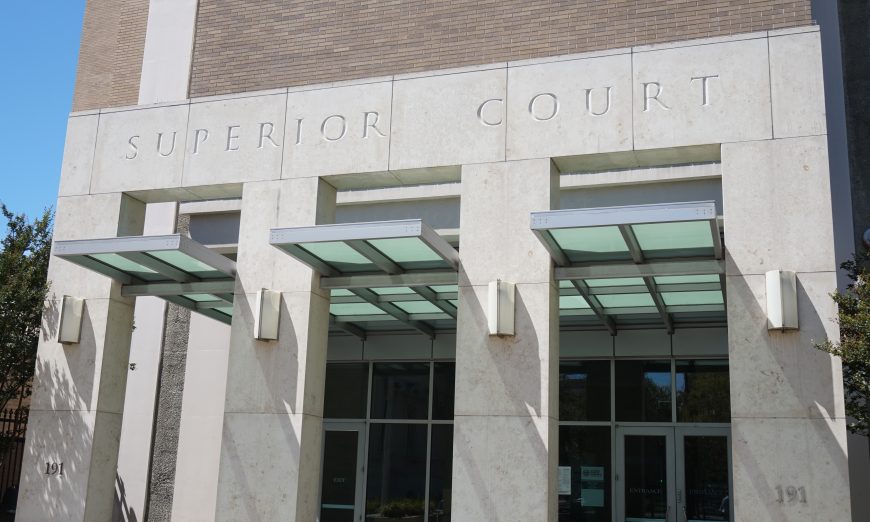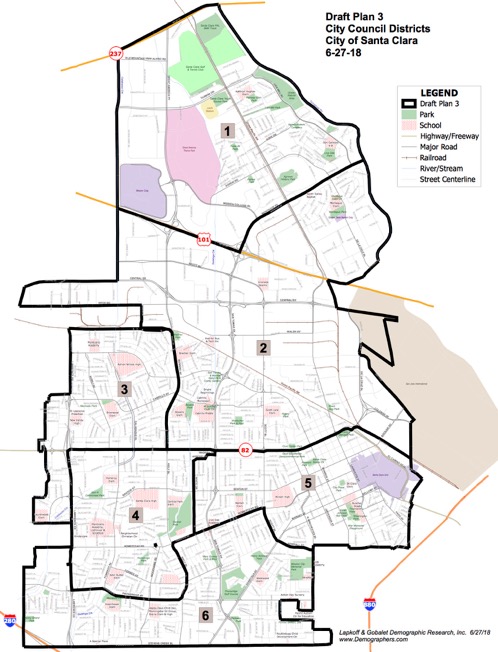Yesterday an amended order was published in Santa Clara’s California Voting Rights Act (CVRA) lawsuit directing the sequencing of elections for the City’s new by-district Council. Superior Court Judge Thomas Kuhnle also ruled that the plaintiffs are entitled to recoup their legal fees and costs — which are likely to be in the millions — and that the Court will oversee the City’s continued compliance with the order.
Districts 2 and 3 will elect their first district representatives in November, and the remaining four districts will elect representatives in 2020. District 2 comprises part of the Northside and most of the City between 101 and El Camino. District 3 goes from the railroad tracks to El Camino and from Bowers to the Sunnyvale border. The City’s mayor will continue to be elected at-large.
In June, Judge Kuhnle found Santa Clara in violation of the CVRA and last week, in a 10-hour trial over three days, the remedy phase of the trial was heard. On Monday, the Judge ordered Santa Clara to create six Council election districts using the City’s Draft Plan 3, dawn by the City’s demographer Jean Gobalet.
Kuhnle’s decision is in keeping with precedent in CVRA court decisions made during the nearly two decades the law has been in effect.
The judge decided for six districts — retaining Santa Clara’s elected mayor — rather than seven as the plaintiffs had asked. “The Court was initially concerned,” Kuhnle wrote, “that having an at-large mayor would not provide remediation to the extent required under the CVRA, which can trump charter city rights.” To date there hasn’t been a ruling in a CVRA case displacing an elected mayor, but it has come up in some cases.
“The Court is also sensitive to the rights of people in California to form charter cities, and the greater degree of autonomy charter cities provide,” he continued. “Draft Plan 3 provides sufficient remediation to comply with law…That fact, combined with the comments made at public meetings …caused the court to conclude that all City voters should continue to elect the City’s mayor.”
He also noted that Santa Clara’s mayor has several “non-substantive powers” that differ from those of other Council Members.
Kuhnle addressed the City’s objection that election precinct boundaries cannot be changed less than 125 days before an election. “The Court believes,” Kuhnle wrote, that the map chosen “does not violate that statute. But even if it did, in balancing the hardships the Court would find the actions necessary to remedy the CVRA violations are so fundamental that a procedural statute should not stand in the way of implementing the plan.”
He continued, “In part this is because if an appropriate remedy is not implemented for the November 2018 elections, these elections would be jeopardized,” referring to Palmdale where that city held another at-large election in 2013 after being found in violation of the CVRA. A court prevented that council from being seated and ordered a by-district election for all council positions.
Judge’s Reasoning: At-Large System Ignored Voters, Single-Member Districts Energized Them, Change Can Happen Immediately
Kuhnle described the testimony that was key in deciding that Santa Clara should make an immediate change to single-member districts.
First was plaintiff Wesley Mukoyama, who testified that in the 40 years he has lived in Santa Clara, candidates “rarely, if ever, knock on his door or otherwise seek his input on matters concerning the city.”
Second was the testimony of Anaheim Mayor Pro Tem José Moreno, who testified that prior to Anaheim’s first by-district election in 2016, many city council members lived in the Anaheim hills, while few lived in the western parts of Anaheim.
“He also testified that [previously] campaigns were costly and that most candidates had to focus on ‘high propensity’ voters,” wrote Kuhnle, “and pay much less attention to other voters.” In his 2016 campaign Moreno “was able to engage all voters…and that elections in his district appeared to be more energized.”
A third factor that influenced the Judge’s order was testimony from Registrar of Voters (RoV) Shannon Bushey that if the RoV had the information it needs by July 23 she was confident her office could support district elections in Santa Clara.
While “district-based elections are more complicated and require more work … in her experience they do not necessarily lead to more errors,” wrote the Judge. The City delivered that data on time.
In choosing City demographer Gobalet’s district map over that of the plaintiff’s expert witness demographer David Ely — both six-district maps were similar — it appeared that decisive factors for the Judge were Gobalet’s familiarity with Santa Clara, her attendance at community meetings since 2012 and her detailed voting age population reports for each of her maps.
City’s Begrudging Compliance
The City is complying with Judge Kuhnle’s order, but expressing no enthusiasm for the change.
Mayor Lisa Gillmor issued a statement on Tuesday, saying, “We celebrate all the different backgrounds, cultures and ethnicities of our residents in Santa Clara. As a Council, we support diversity and want all our residents to feel represented.”
However, Gillmor continued, “While the City will comply with the order for the upcoming election, there is concern that it changed the election system overall without seeking robust input from all our residents.”
In its communications this week, the City framed by-district elections as denying two-thirds of the City the right to vote for the City Council in 2018. In a Monday press release the City called the judge’s order “in conflict” with Santa Clara’s charter. This was changed to “effectively amends the City’s Charter” in a revised statement that went out later.
After Judge Kuhnle ordered the City early this month to develop single-member district maps and to hold four public meetings on them, the City held the meetings but complained continuously that there wasn’t enough time.
The City also appealed this judicial order with arguments that turned on the meanings of the words “mandatory” and “injunction.” The appeal was dismissed after the City failed to file a brief.
Missed Opportunities to Avoid Lawsuit
Santa Clara has had abundant opportunity in the last seven years to get “robust input” on its election system and has repeatedly ignored “input” that suggested its at-large by-seat system violated state law and was vulnerable to a CVRA lawsuit.
Santa Clara got its first CVRA violation warning from Robert Rubin in 2011, and has since convened three charter review committees to address the City’s at-large election system.
The Council ignored the recommendation of the 2012 committee to, at a minimum, eliminate the by-seat system — it was an election year.
A 2016 committee decided not to deal with elections — without objection from the City Council, even though that was the purpose for which the committee was formed. That too, was an election year.
In October 2016 Santa Clara received its second warning letter from Rubin, and early in 2017 the current lawsuit was filed. The third charter review committee to consider the election question was seated in February 2017 and devised the losing two-by-three/single transferable vote system for the June 2018 ballot.
When Measure A was defeated, the City was on-course to conduct another at-large election until Judge Kuhnle enjoined the RoV from running another at-large Santa Clara election.
Does the CVRA Trump the City Charter?
The City has repeatedly made the claim that a court can’t make changes to the Santa Clara charter.
“Any change to the City’s election system requires a change to the City Charter, which can only occur by a vote of the majority of the City’s voters,” wrote the City’s legal counsel, Steven Churchwell, in his trial brief. City Attorney Brian Doyle has repeatedly questioned the authority of the CVRA over charter cities.
The argument over CVRA preemption of city charters isn’t a new one.
In the 2013 Palmdale CVRA case an appeals court found that the CVRA preempted charter city law because it involved statewide concerns — voting rights, equal protection and electoral integrity — and concluded that the California Constitution’s “home-rule” provisions didn’t prevent enforcement of the CVRA in charter cities.
Palmdale’s case cost that city over $4 million in plaintiff’s legal fees and an estimated $2-3 million in the city’s own legal costs, according to local newspaper reports. (Palmdale, like Santa Clara, refuses to report its legal costs, claiming such disclosure violates attorney-client privilege.)
Santa Clara has already spent at least $90,000 since October on attorney’s fees according to City payment registers, and that number doesn’t include the April and July trials.







